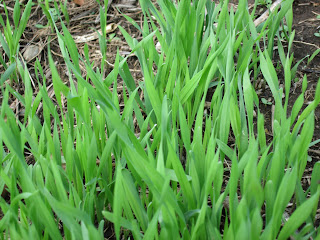Reasons for planting cover crops include reducing soil erosion, increasing soil fertility and maintaining moisture in the soil. Bare soil is open to erosion both from wind and heavy rain.
Bare soil tends to develop a crust which prevents moisture from soaking in, especially in a hard rainfall. This happens in the "washes" of the the American Southwest where there are dangerous flash floods annually. This suspension bridge (below) in Boyce Thompson Arboretum in Arizona seems completely unnecessary. But in the monsoon season the creek bed underneath will instantly become a wild and rushing torrent.
 |
| Suspension bridge in Boyce Thompson Arboretum, Arizona |
Here in Toronto in the case of Keating Channel where the Don River empties into Lake Ontario, the banks of the river have been replaced with concrete and metal walls so the water doesn't have a chance to leach slowly into what was originally a naturally occurring flood plain.
 |
| Mouth of the Don River with concrete walls |
When cover crops are planted to increase soil fertility they are called green manure. These cover crops can be selected to contribute specific nutrients to the soil. Legumes, for example, are planted because they can fix nitrogen from the air in the soil. But any cover crop will add organic matter when turned into the soil. The continued process of adding biomass will slowly improve soil structure, water retension and microbial life.
I was able to get some organic rye seeds from my farmer friend, Charlie, to plant in the new beds in the field after I had dug the potatoes. Next spring I will spread compost over the rye and then turn it into the soil. If the soil is poor then cover crops can actually deplete nutrients as the decompose. So spreading manure or compost before turning in the cover crop should ensure that it is actually contributing (and not removing) fertility.
 |
| Rye on the left and Dutch white clover on the path |
 |
| Rye three weeks after sowing |
 |
| Clover germinating on the path |
No comments:
Post a Comment